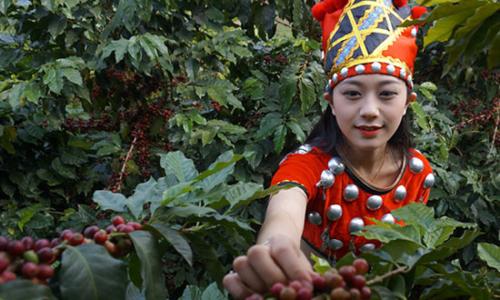Taste treatment of Tippi Katim Coffee beans A brief introduction to the Grinding scale Manor
Taste treatment of Tippi Katim Coffee beans A brief introduction to the Grinding scale Manor
Catimor: Katim is not pure Arabica, it is a hybrid of Timor (which belongs to Robusta) and caturra (a variety of Bobang), so catimor has 25% Robusta blood, and its Robusta blood also determines its taste defects: the aroma is not rich enough, and the overall taste is bitter, prone to astringency and more irritating mildew.
All the varieties planted in Pu'er area of Yunnan are catimor (Katim). In Baoshan City, typica and bourbon were introduced as early as the 1950s, and the locals called them "old varieties". Because the old varieties have low disease and insect resistance and yield, and the management is relatively expensive and manpower, coupled with the market purchase price does not have many advantages, brown farmers have changed to a new variety catimor in recent years. From the botanical point of view of coffee, Yunnan small-grain coffee is genetically similar to the recognized best blue mountains in Jamaica (Jamaica Blue Mountain) and Kona in Hawaii.
Coffee is a long-term economic crop, woodland reclamation must be long-term planning, good planning, before reclamation must do a good job of road, shed, fertilizer pool design. When reclaiming woodland, shade trees should be selected to make the coffee woodland after planting have 30% shade, and then adjust to 20%. In planning and design, we must do a good job in the planning and reclamation of horizontal terraces and terraces, which is not only the primary task of soil and water conservation, but also an important work to bring convenience to field management after planting. Trenching, with the specification of upper mouth width × depth × bottom width 60 × 50 × 40cm, will be reclaimed before the end of November to the end of March of the following year.
3000-4000kg high quality organic fertilizer per mu, phosphate fertilizer 80-120kg returned to the hole 15 days before planting (organic fertilizer, phosphate fertilizer and soil were mixed well and applied into the planting ditch).
Strong seedling planting
Select seedlings with robust growth, close to branches or 3 pairs of branches, stout main stem, stem diameter above 0.4cm, and no curved root. The irrigated land can be planted in advance (February-March), and the planting row spacing depends on the topographic environment, usually planting 330mi 420 plants per mu.

Important Notice :
前街咖啡 FrontStreet Coffee has moved to new addredd:
FrontStreet Coffee Address: 315,Donghua East Road,GuangZhou
Tel:020 38364473
- Prev

Description of taste and flavor of Panamanian butterfly coffee beans brief introduction of regional varieties
A brief introduction to the taste and flavor of Panamanian butterfly coffee beans there are many ways of washing, but generally speaking, the floating beans are removed after the coffee fruit is picked, then the pulp is removed, and then the coffee beans are soaked in a fermentation trough. The enzymes in the water will soften the mucus attached to the endocarp of the coffee beans, and the natural yeast will break down the sugar in the mucus, a process called fermentation.
- Next

The taste of Lazimus coffee beans in Colombia is treated with the degree of grinding.
The degree of Grinding of Colombian Lazmos Coffee beans the varieties of Colombian coffee produced in France are mainly small-grain coffee. Plants are small trees or large shrubs, 5-8 m tall, usually much branched at base; old branches gray-white, nodes dilated, young branches glabrous, compressed. Leaves thinly leathery, ovate-lanceolate or lanceolate, 6-14 cm long and 3.5-5 cm wide, tip long acuminate, acuminate
Related
- Detailed explanation of Jadeite planting Land in Panamanian Jadeite Manor introduction to the grading system of Jadeite competitive bidding, Red bid, Green bid and Rose Summer
- Story of Coffee planting in Brenka region of Costa Rica Stonehenge Manor anaerobic heavy honey treatment of flavor mouth
- What's on the barrel of Blue Mountain Coffee beans?
- Can American coffee also pull flowers? How to use hot American style to pull out a good-looking pattern?
- Can you make a cold extract with coffee beans? What is the right proportion for cold-extracted coffee formula?
- Indonesian PWN Gold Mandrine Coffee Origin Features Flavor How to Chong? Mandolin coffee is American.
- A brief introduction to the flavor characteristics of Brazilian yellow bourbon coffee beans
- What is the effect of different water quality on the flavor of cold-extracted coffee? What kind of water is best for brewing coffee?
- Why do you think of Rose Summer whenever you mention Panamanian coffee?
- Introduction to the characteristics of authentic blue mountain coffee bean producing areas? What is the CIB Coffee Authority in Jamaica?

